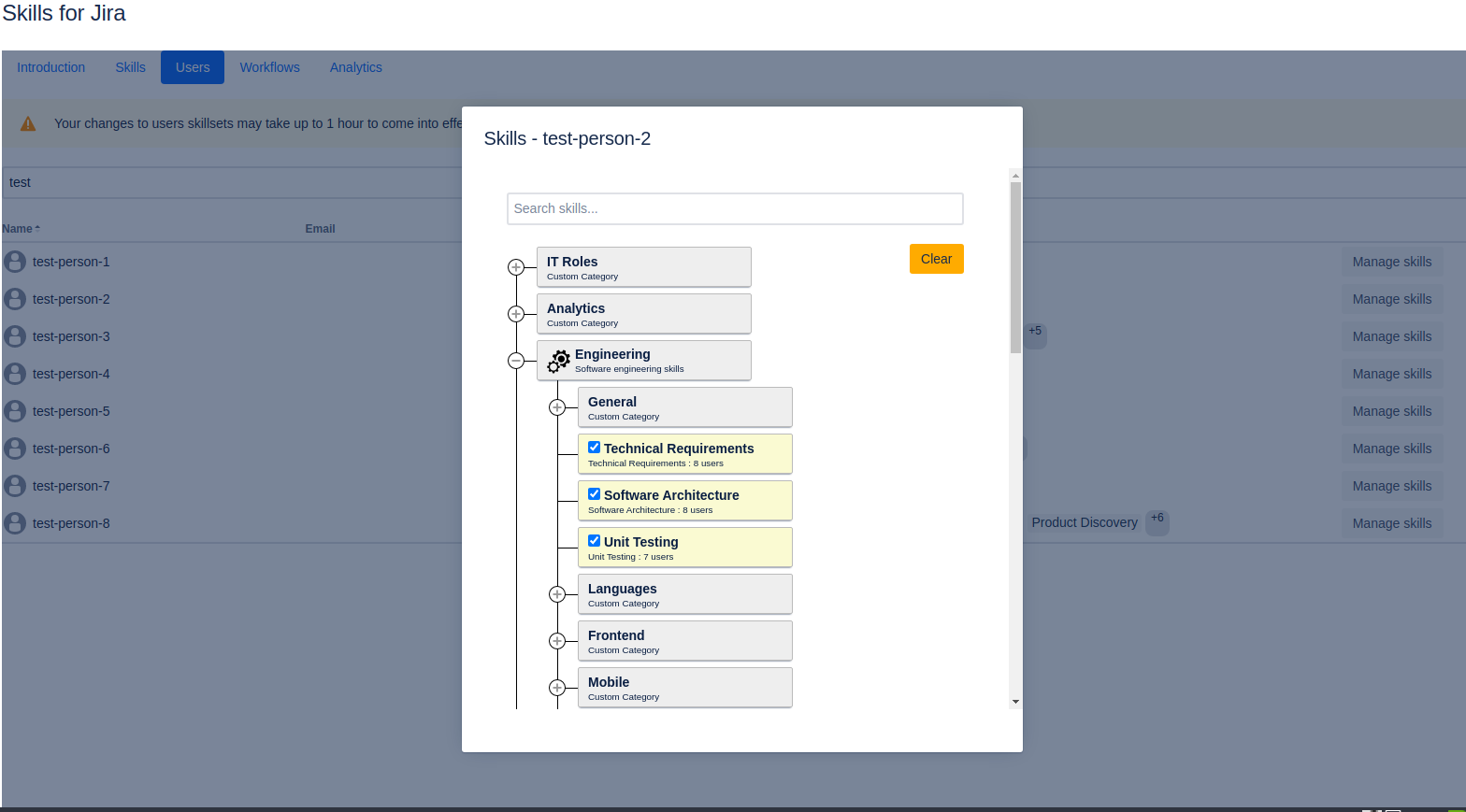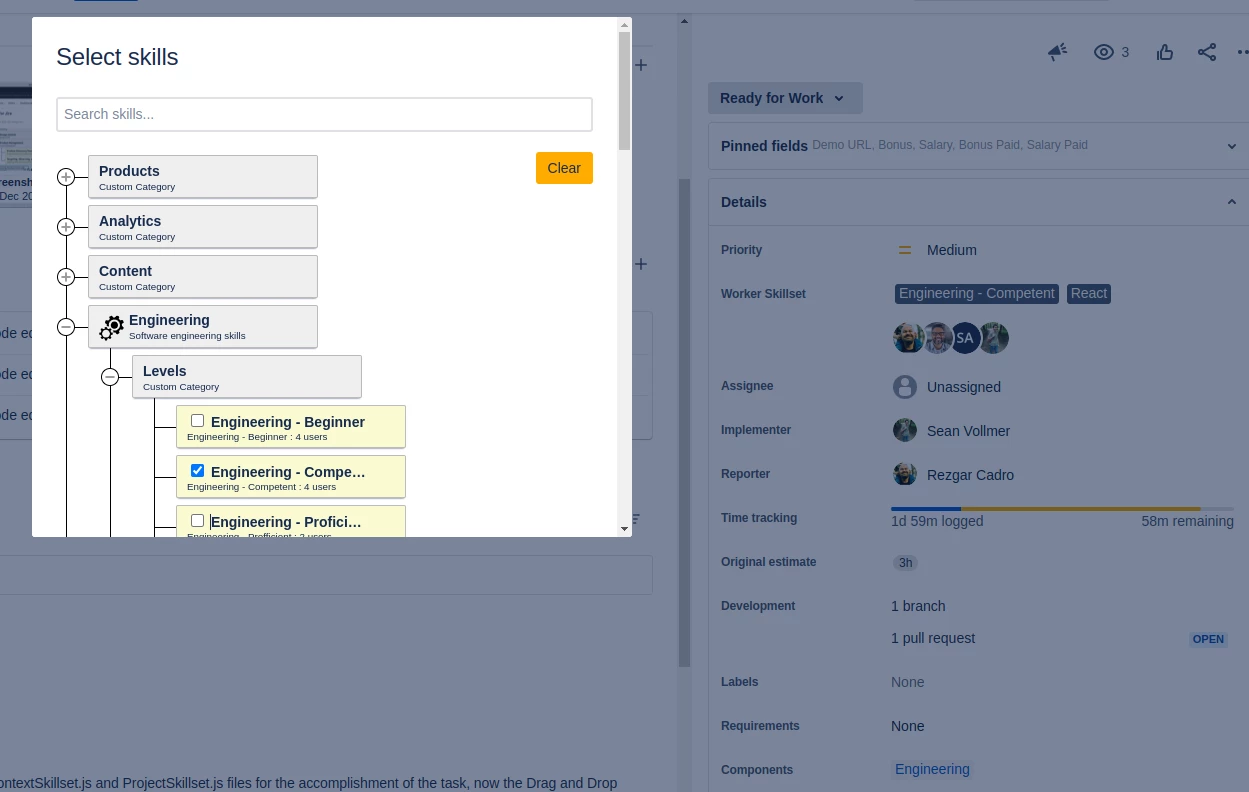Versions Compared
Key
- This line was added.
- This line was removed.
- Formatting was changed.
1. Create a "Skillset" custom field
https://www.youtube.com/watch?v=gQnIRU89evACreate a "Skillset" custom field
The Skillset field is where you will be specifying skill requirements for your issues.
Qualified experts will be identified automatically and shown to you directly on the issue screen along with the skills
You can create multiple Skillset fields to model your use case
You can customize the skill tree on a field, project, or issue type level with custom field contexts
A sidecar field “Skillset-Experts” will be created and maintained automatically by Skills for Jira to let you address experts in other applications or Jira features that do not support Skillset fields.
| Note |
|---|
You can rename your “Skillset” field at any time, however you must rename the sidecar “Skillset-Experts” field as well, maintaining the naming convention (i.e. “New Skillset name-Experts”) |
2. Configure skills relevant for your organization
https://www.youtube.com/watch?v=TLImGNlI2HsOpen the "Skills for Jira" administration console (“Apps / Manage your apps” menu)
Open the "Skills" tab
Modify/delete the default skills, add your own, and organize them into categories as you see fit
You can export your skills configuration for backup or migration purposes
You can also always reset your skills configuration to the out-of-the-box defaults
| Warning |
|---|
Skill Tree size limitationDue to the platform limitation, your skill tree can not exceed 32kb in JSON form. If the current limitation is insufficient for your needs, please contact Support. |
| Info |
|---|
You can override your skills on the Project or Custom Field Context levels. It can be done in the respective configuration sections:
|
3. Configure your team members' skill sets

Open the "Skills for Jira" app configuration section
Open the "Users" tab
Search for users you want to update
Use the "Modify Skills" button to configure user's skills
Note: Changes to user's skills do not immediately propagate to all issues. Propagation might take 1 hour or more, depending on the size of your Jira instance.
| Info |
|---|
User skills information is foundational for all Skills for Jira features. It is used for showing you the Organization Knowledge Graph, qualified experts on each issue, self-service assignments, expert-only transitions or analytics. |
4. Enable self-service assignments
https://www.youtube.com/watch?v=8icRgAOPfwc&t=19sOpen the Settings / Apps / Skills for Jira - Administration Console
Open the "Assignments" tab
Configure the Default Queue with Self-service assignment method or create specialized work queues and assign them to specific user groups
Configure your work queues:
Scope
JQL filter that represent the scope of issues the relevant user groups will work on
The JQL filter must include issues waiting to be pulled as well as issues in progress
The JQL filter must be shared with your users
Ready for work (statuses)
Issues in these statuses will be pulled by your users when clicking “Get next task” in their dashboards
In progress (statuses)
When you users pull assignments, they will be transitioned into one of these statuses, depending on your workflow configuration
Qualification (field)
This field defines the skill requirements for workers. Only issues for which the user has all the necessary skills show up in user’s work queue.
Once Self-service assignments are enabled, your users will gain access to their personal Apps / Skills for Jira - User Console / Assignments dashboard as well as the Self-service assignments gadget that you can add to your existing dashboards
The dashboard will allow them to get their next most important task in one click
Skills for Jira will inspect all work queues relevant for the user and assign the highest priority task to the user
5. [OPTIONAL] Enforce expert-only transitions
https://www.youtube.com/watch?v=oDt_SXl_jz8Open your Jira Workflow for editing
Select the Transition of interest
Configure workflow conditions as on the screenshot below:
“Any of the following conditions” should be true:
Add a standard workflow condition "User Is In Custom field"
Use the "Skillset field name-Experts" field as a target
“All of the following conditions” should be true (condition group)
“Skillset field name” is empty
“Skillset field name-Experts” is empty
Workflow conditions in the demo are configured to restrict transition to “In Progress” to Experts only if the expertise requirements are specified. Otherwise anyone can work on the task.
The extra conditions are there to allow the transition when no skills are selected (in which case the Experts field will be empty as well).
By attaching this Workflow Condition to transitions to "In Progress", you could prevent any user who lacks the required expertise from getting the issue
| Info |
|---|
You can get much more creative with "Skillset" fields and Jira workflows if you are using Jira addons that offer custom workflow extensions like Script Runner for Jira Cloud. For example, you could prevent transitions if there's another user with the required skillset, who has better availability. You could do that by reading the |
6. Start specifying skill requirements for your issues

Make sure that your new Skillset field is added to your issue screens (i.e. Create, View screens)
Open any issue and click on your Skillset field. You will see your customized skill tree to choose skills from
Use search or tree navigation to find and select skills
Submit and wait while Skills for Jira finds the matching experts
| Note |
|---|
Matching experts will take ~1from 3 seconds to 1.5 minutes even on small Jira installations. This is due to the Atlassian Forge platform limitations. The delay will be reduced or removed as the Atlassian Forge platform evolves. |
These skill requirements are then used to show you qualified experts, give you your next most important task on demand, help you spot knowledge gaps or bottlenecks and more.
and
Open the Apps / Skills for Jira - User console menu
Open the "Analytics" tab
Define the scope of your analysis by writing a JQL query or selecting one of your existing filters
Check the "Skills" section for a birds eye view of skills requirements of your issues.
The "Scarce skillsets" sub-section will also show you the skill sets that are scarce among your team (few or no users have the skill combination)
Check the "Issues Affected" section for issues that demand scarce skill sets
Check the "Bottleneck Experts" section to identify team members that possess unique or scarce knowledge that is in demand with the scoped issues.
more
.
Related pages
| Filter by label (Content by label) | ||||||||||||||
|---|---|---|---|---|---|---|---|---|---|---|---|---|---|---|
|